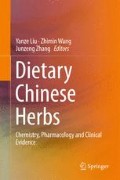Abstract
Carthamus tinctorius L. (safflower) is a widely used traditional Chinese medicine, which has been used to treat dysmenorrhea, amenorrhea, postpartum abdominal pain and mass, trauma and pain of joints in China for many years. This article summarizes the up-to-date and comprehensive information on safflower covering the aspects of the botanical identity, chemical constituents, pharmacological studies, TCM applications and dietary usage, clinical evidences, quality evaluation and assurance, and safety evaluation and toxicity issue. Carthamus tinctorius L. is an annual or biennial herbal plant in the family of Compositae, and its tubular flowers have been used as the medicinal material. In terms of chemical constituents, quinochalcones and flavonoids are considered as the characteristic and active constituents of safflower. In accordance with the traditional application and clinical practice of safflower, modern pharmacological studies have also demonstrated that safflower possesses a wide range of medicinal functions, such as dilating coronary artery, improving myocardial ischemia, modulating immune system, anticoagulation and antithrombosis, antioxidation, antiaging, antihypoxia, antifatigue, anti-inflammation, antihepatic fibrosis, antitumor, analgesia, etc. What is more, quality control and toxicity issues are also presented to have a better understanding of safflower.
Access this chapter
Tax calculation will be finalised at checkout
Purchases are for personal use only
References
Pharmacopoeia Committee of People’s Republic of China (2010) Pharmacopoeia of People’s Republic of China. Chemical Industry Publishers, Beijing (in Chinese)
Li, Wu (1982) Carthamiflos. China Agriculture Press, Beijing (in Chinese)
Jun et al (2011) New polyacetylene glycosides from the florets of Carthamus tinctorius and their weak anti-inflammatory activities. Carbohydr Res 346(13):1903–1908
Akihisa et al (1994) Erythro-hentriacontane-6,8-diol and 11 other alkane-6,8-diols from Carthamus tinctorius. Phytochemistry 36:105–108
Wu et al (2011) Research progress on chemical composition and the effects of cardiovascular and cerebral vessels of safflower yellow. Qilu Pharm Aff 30(8):481–484 (in Chinese)
Lee et al (2002) Antioxidative flavonoids from leaves of Carthamus tinctorius. Arch Pharmacal Res 25(3):313–319
Sareng et al (2009) Summary of the research on chemical compositions and pharmacological activities of Mongolian Drug Carthamus tinctorius L. J Inner Mongolia Univ Nationalities 24(3):333–336 (in Chinese)
Tang (2003) Science of Chinese Materia Medica. Publishing House of Shanghai University of Traditional Chinese Medicine, Shanghai
Zhang et al (2010) Research progress on Honghua and its compound preparations. China Pharm 13(7):1033–1034 (in Chinese)
Gu (2005) Encyclopedia about Chinese family medicinal dishes. TCM Ancient Books Publishing House, Beijing (in Chinese)
Peng (2004) Chinese medicinal dishes of four seasons for liver diseases. Central Plains Farmer Publishing House, Zhengzhou (in Chinese)
Tan (2009) Chinese medicinal dishes and dietotherapy. Chinese Press of Traditional Chinese Medicine, Beijing (in Chinese)
Peng (2004) 60 kinds of wine, drink and drug food. Zhuhai Publishing House, Zhuhai (in Chinese)
Xiao, Hu (2011) Clinical effect of hydroxysafflor yellow A injection on acute ischemic apoplexy. Medicine Journal of West China 23(5):932–933 (in Chinese)
Li (2012) Clinical effect of Honghua injection on coronary disease and angina pectoris. China J Guang Ming Chin Med 27(1):83–84 (in Chinese)
Pang (2012) Clinical effect of hot and wet dressing with Honghua on the prevention of chemotherapy-induced phlebitis. Forum Trad Chin Med 27(2):40 (in Chinese)
Yang et al (2012) Observation of the clinical efficacy of Dan Hong injection in the treatment of acute cerebral infraction. China J Misdiagnosis 12(8):1809 (in Chinese)
Li et al (2011) Clinical study of Honghua injection in the treatment of acute gouty arthritis. China Med Pharm 1(8):123–124 (in Chinese)
Wang (2012) Clinical observation of safflower Yellow in combination with low molecular weight heparin to treat unstable angina. Pub Med Forum Mag 16(4):462–463 (in Chinese)
Zhang, Xu (1997) Summary of the clinical application of Honghua. J Chin Materia Medica 22(7):439–440 (in Chinese)
Liu et al (2012) Study on the genetic toxicity of Honghua. China J Pharm Econ 2:156–157 (in Chinese)
Yu et al (2011) Study on the long-term toxicity of Compound Honghua dripping pill on rats. Li Shizhen Med Mat Medica Res 22(1):103–105 (in Chinese)
Lin et al (1998) The toxicity and impact of Honghua on the pregnancy and embryonic development of rats. J Anhui TCM Coll 17(4):50–51 (in Chinese)
Author information
Authors and Affiliations
Corresponding author
Editor information
Editors and Affiliations
Rights and permissions
Copyright information
© 2015 Springer-Verlag Wien
About this chapter
Cite this chapter
Wang, Z., Zhou, X. (2015). Carthamus tinctorius L. 红花 (Honghua, Safflower). In: Liu, Y., Wang, Z., Zhang, J. (eds) Dietary Chinese Herbs. Springer, Vienna. https://doi.org/10.1007/978-3-211-99448-1_76
Download citation
DOI: https://doi.org/10.1007/978-3-211-99448-1_76
Published:
Publisher Name: Springer, Vienna
Print ISBN: 978-3-211-99447-4
Online ISBN: 978-3-211-99448-1
eBook Packages: Chemistry and Materials ScienceChemistry and Material Science (R0)

